Bali
ISLAND OF THE GODS
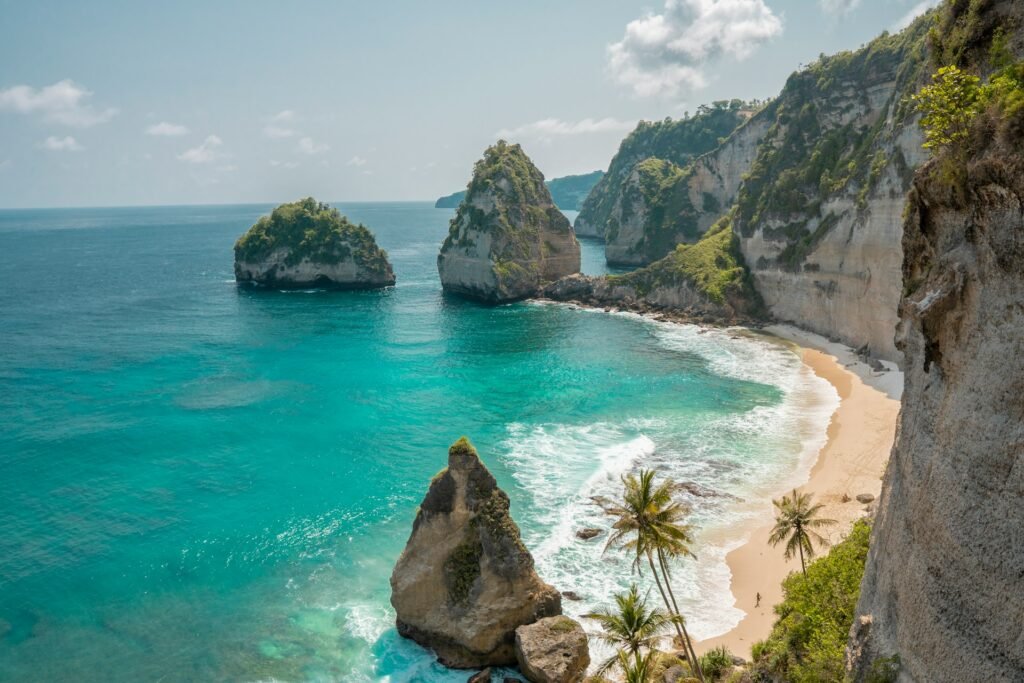
Bali, Indonesia’s tropical gem, is a paradise where lush jungles, turquoise waves, and ancient temples create a backdrop that feels like a dream. Stroll through Ubud’s rice terraces, where emerald fields sway under the sun, or catch a sunset at Tanah Lot, a temple perched dramatically on a rocky outcrop. The island’s vibrant culture shines in every corner—think colorful offerings, gamelan music, and warm smiles from locals. Whether you’re bartering at Ubud Market or sipping a coconut on Kuta Beach, Bali’s energy is infectious, with a laid-back vibe that makes exploring by scooter or foot a joy.
It helps keep this site running, and we appreciate your support!
Sightseeing
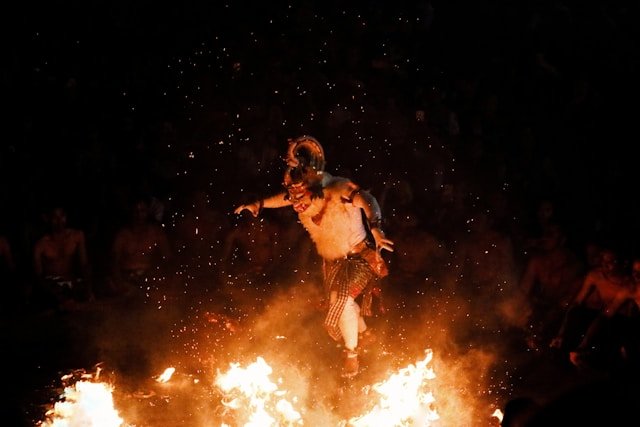
Uluwatu Temple
Perched on a cliff 70 meters above the Indian Ocean, this ancient Hindu temple is a stunner, especially at sunset when the sky blazes orange and waves crash below. Known as Pura Luhur Uluwatu, it’s one of Bali’s sacred sea temples, built to protect the island from evil spirits. The kecak dance performance at dusk—a mesmerizing chant-and-dance ritual—is a must-see, though book tickets early as it fills fast. Monkeys roam the grounds, so hold onto your sunglasses and avoid feeding them. The coastal views stretch endlessly, and a short walk along the cliff path reveals hidden coves. It’s a spiritual and scenic knockout, best visited late afternoon to catch both the temple’s calm and the evening show.
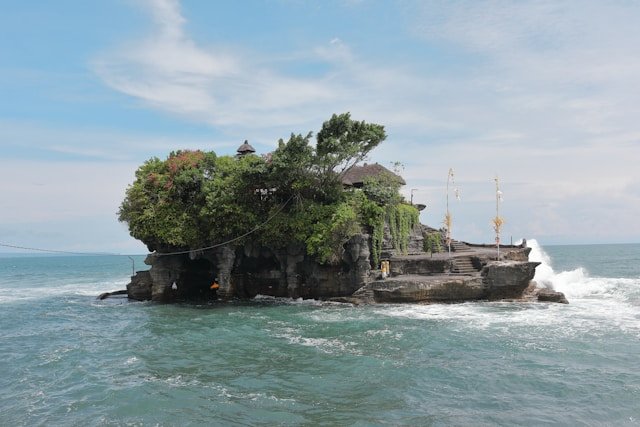
Tanah Lot Temple
Jutting out into the sea on a rocky islet, this iconic temple feels like it’s floating when tides roll in, creating a postcard-perfect scene. Built in the 16th century to honor sea gods, it’s a pilgrimage site for Balinese Hindus, though tourists can’t enter the main shrine—still, the surrounding courtyards and ocean views are plenty to soak in. Sunset is prime time, with crowds gathering to snap photos as the temple glows against the horizon. Nearby stalls sell souvenirs and snacks, but the real draw is the dramatic setting, especially during low tide when you can walk closer. Arrive early to beat the rush and feel the sacred vibe of this coastal gem.

Tegalalang Rice Terraces
Just north of Ubud, these emerald-green terraces cascade down hills like a living sculpture, showcasing Bali’s ancient irrigation system, a UNESCO World Heritage Site. Walking the paths, you’ll dodge selfie sticks but also catch glimpses of farmers tending rice under palm trees—it’s Bali’s rural heart in full view. Cafes perched along the edges serve luwak coffee with terrace views, though prices reflect the touristy vibe. Wear sturdy shoes for muddy trails and bring cash for small entry donations (about $1-2). Mornings are cooler and quieter, letting you savor the serenity before buses roll in. It’s a lush, cultural must-see that captures Bali’s agrarian soul.
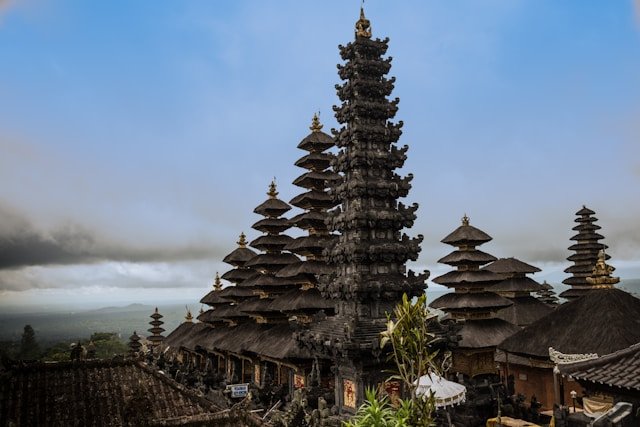
Besakih Temple
Known as the “Mother Temple,” this sprawling complex on Mount Agung’s slopes is Bali’s holiest site, with over 80 temples dating back centuries. Its tiered shrines and stone gates feel like a journey into the divine, though you’ll need a sarong (rentable on-site) to enter respectfully. Local guides can explain the rituals—some push for tips, so agree on fees upfront. The high altitude means cooler air, but the hour-long drive from Ubud tests patience on winding roads. Views of misty peaks reward the trek, especially on clear days. Visit midweek to avoid festival crowds and feel the spiritual weight of Bali’s largest sacred site.
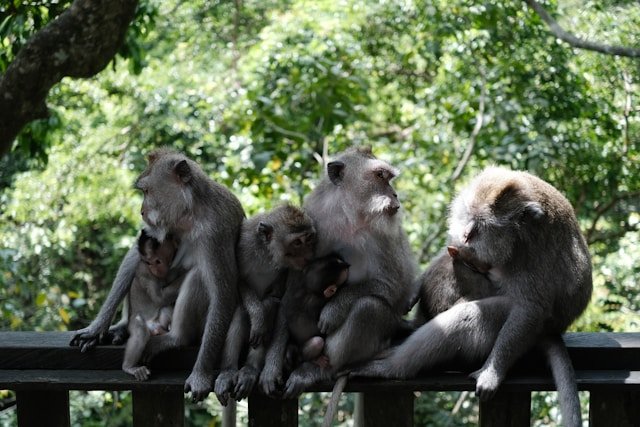
Ubud Monkey Forest
This lush sanctuary in central Ubud is home to over 1,000 cheeky macaques who rule the roost amid ancient trees and mossy temples. The 12-hectare forest feels like a jungle escape, with stone paths winding past banyan trees and a sacred spring. Monkeys will snatch anything loose—hide snacks, secure glasses, and skip selfies with them to avoid trouble. Staff keep things orderly, but it’s wise to follow signs and avoid eye contact with the primates. The forest’s three temples, like Pura Dalem Agung, add a spiritual layer, though they’re off-limits to non-worshippers. It’s a fun, slightly wild stop, best early morning for fewer people.
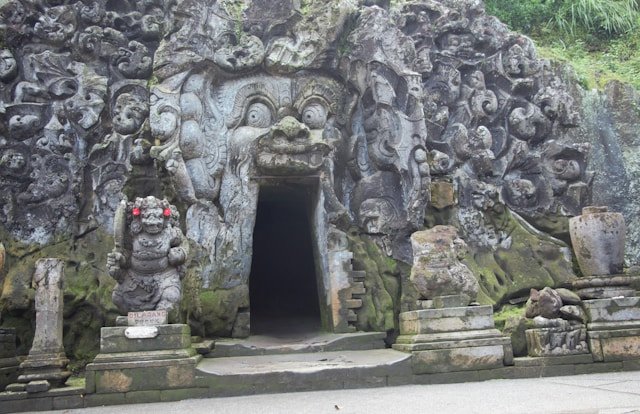
Goa Gajah (Elephant Cave)
Tucked near Ubud, this 9th-century site blends mystery and history, with its carved cave entrance—a snarling demon’s mouth—drawing you into a dark chamber used for meditation. Outside, a bathing pool with stone maidens pouring water feels like an archaeological find, rediscovered in the 1920s. The surrounding jungle and rice fields add a tranquil vibe, though the small site gets busy by midday—arrive at opening (8 AM) for peace. A sarong’s required (included with the $3 ticket), and nearby stalls sell coconut water. It’s a compact but evocative stop, perfect for history buffs wanting a taste of Bali’s ancient past.

Jatiluwih Rice Terraces
Sprawling across 600 hectares, these UNESCO-listed terraces in central Bali dwarf Tegalalang with their vast, rolling beauty—think endless green waves under Mount Batukaru’s gaze. Less touristy than Ubud’s fields, Jatiluwih offers quiet trails where you can bike or trek past farmers and water buffalo. Entry’s about $3, plus a small village donation, and guided tours explain the subak irrigation system that’s sustained Bali for centuries. Morning light makes the terraces glow, and cooler highland air (around 65°F) keeps walks pleasant. It’s a serene, off-the-beaten-path gem for nature lovers craving Bali’s rural roots.
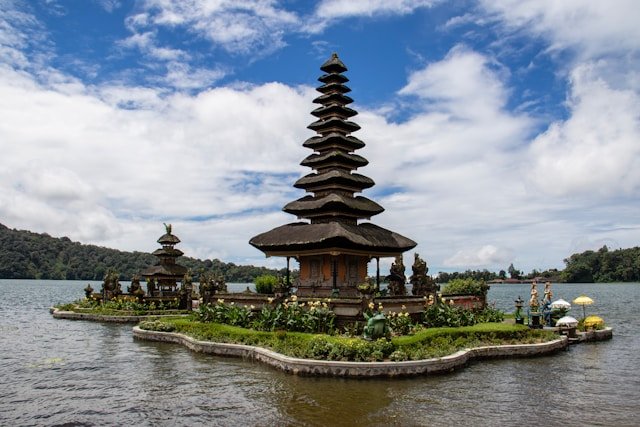
Pura Ulun Danu Bratan
Floating on Lake Bratan’s edge in Bedugul, this 17th-century temple looks like it’s straight out of a painting, with its multi-tiered roofs mirrored in misty waters. Dedicated to the water goddess Dewi Danu, it’s vital for Bali’s farmers, who rely on the lake’s irrigation. The highland setting (1,200 meters up) means chilly mornings—bring a jacket—and the gardens bloom with marigolds. Boats for rent let you glide closer, though the temple’s inner sanctum is for worshippers only. Visit early to avoid tour groups and catch the fog lifting off the lake. It’s a peaceful, photogenic must for cultural explorers.
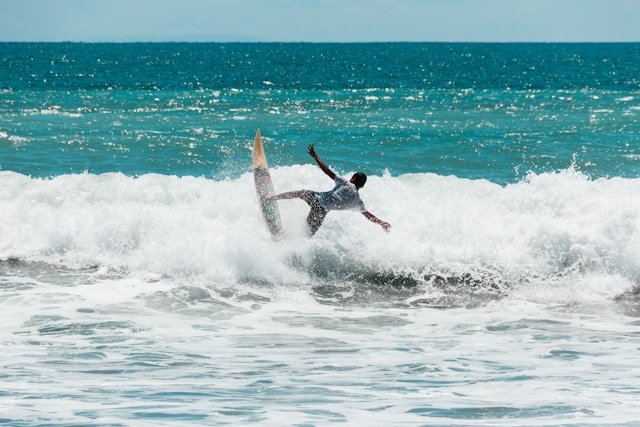
Kuta Beach
Bali’s original tourist hub, this lively stretch of golden sand buzzes with surfers, sunbathers, and vendors selling Bintang beer or sarongs. The waves are beginner-friendly, with surf schools lining the shore—lessons start at $20—and the beachfront strip pulses with bars and warungs for cheap eats like sate lilit. Sunsets here are legendary, painting the sky crimson as crowds gather. It’s not Bali’s quietest spot; hawkers can be persistent, so a polite “no” keeps them at bay. Hit it in the morning for a cleaner beach and fewer people—it’s a classic Bali vibe, perfect for soaking up the island’s carefree spirit.
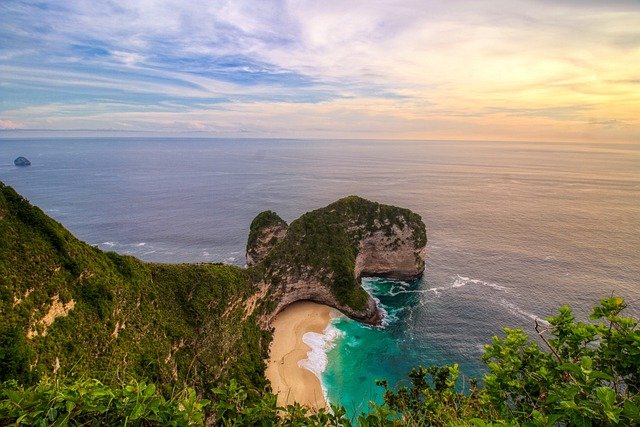
Nusa Penida’s Kelingking Beach
A bumpy ferry ride from Sanur lands you on Nusa Penida, where this cliff-framed beach stuns with its T-rex-shaped rock and turquoise lagoon far below. The steep, 400-step hike to the sand is a sweaty 45-minute challenge—flip-flops won’t cut it, so wear sneakers. Swimming’s risky due to strong currents, but the viewpoint alone, with its jaw-dropping panorama, is worth the trip. Mornings beat the Instagram rush, and a $1 entry fee keeps it accessible. Pair it with nearby Broken Beach for a full day of rugged beauty. It’s Bali’s wild side, a trekker’s and photographer’s paradise.
Activities
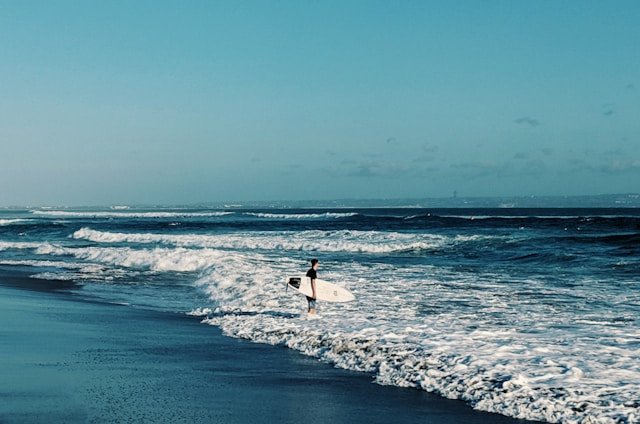
Surfing in Canggu
Catching waves in Canggu’s black-sand beaches like Echo or Batu Bolong is a Bali rite, with breaks for beginners and pros alike. Surf schools abound—expect $25-40 for a 2-hour lesson with board rental—and the vibe’s laid-back, with beach cafes serving smoothies post-session. Mornings offer cleaner waves before winds pick up, and local instructors share tips on reading Bali’s swells. Crowds can clog peak season (July-August), so paddle out early or try quieter Old Man’s break. It’s not just a sport here; it’s a lifestyle, blending adrenaline and Bali’s chill coastal spirit—perfect for thrill-seekers.
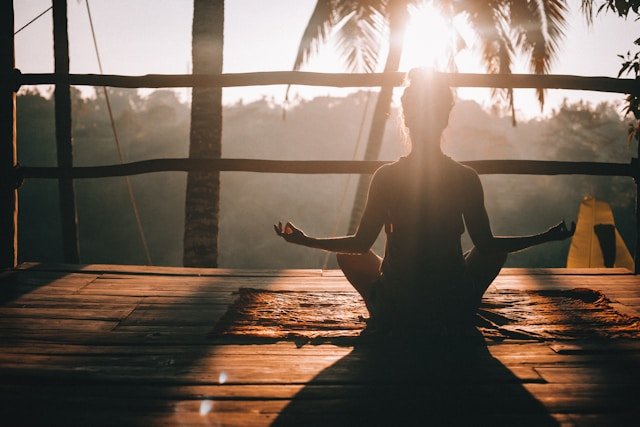
Yoga in Ubud
Finding your zen in Ubud’s jungle studios is a soul-soothing must, with world-class yoga retreats like Yoga Barn offering drop-in classes for $10-15. From vinyasa to yin, sessions cater to all levels, often set in open-air shalas with rice field views—expect to sweat in Bali’s humidity. Teachers blend spirituality with technique, and many spots add meditation or sound healing for deeper vibes. Book ahead for popular classes, and bring your own mat if you’re picky. It’s a transformative way to tap into Bali’s wellness scene, ideal for those craving calm amid the island’s buzz.
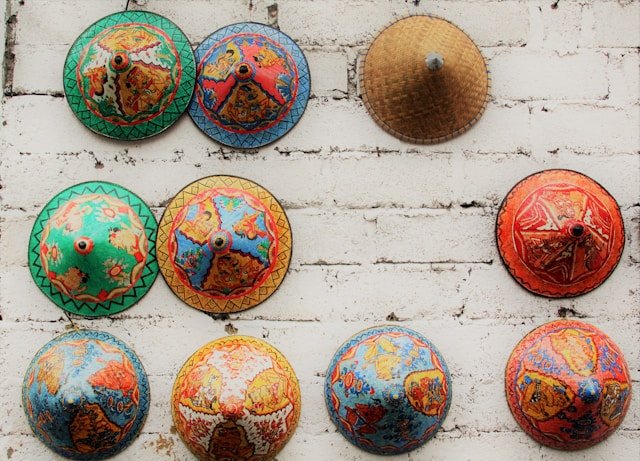
Exploring Ubud Art Market
Diving into this bustling market on Jalan Raya Ubud is a sensory feast, with stalls piled high with batik sarongs, silver jewelry, and carved masks. Haggling’s the game—start at half the asking price and keep it friendly; a smile goes far. You’ll find treasures for $2-20, though quality varies, so inspect goods closely. Mornings are less hectic, letting you browse before tour groups flood in. Pair it with a $1 nasi campur lunch at a nearby warung. It’s a vibrant, budget-friendly way to snag souvenirs and feel Bali’s creative pulse—perfect for shoppers and culture buffs.

Hiking Mount Batur at Sunrise
Trekking this active volcano for a 5 AM summit sunrise is a bucket-list adventure, with a 2-hour climb (guided, $30-50) revealing Bali’s highlands bathed in golden light. The trail’s moderate but rocky—wear hiking shoes and bring a flashlight. At 1,717 meters, the crater view and steaming vents feel otherworldly, and guides often cook eggs on volcanic heat for breakfast. Book a reputable tour to avoid sketchy operators, and expect chilly pre-dawn temps (50°F). It’s a sweaty, rewarding haul for nature lovers wanting Bali’s raw, rugged side.
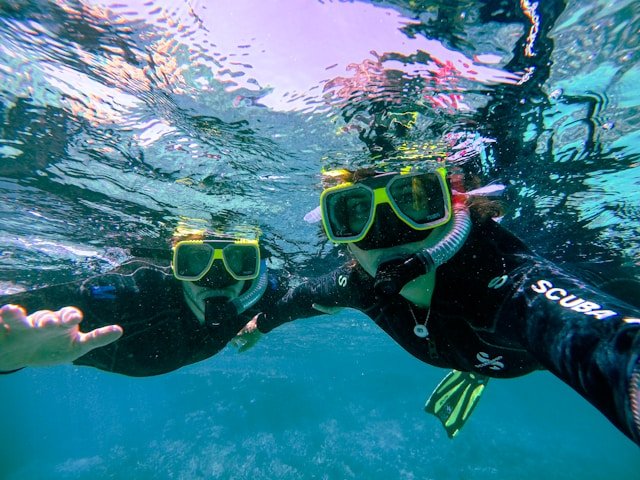
Snorkeling in Amed
Slipping into Amed’s calm, coral-rich waters on Bali’s east coast is a budget diver’s dream, with vibrant reefs and Japanese shipwrecks just offshore. Local operators charge $10-20 for a half-day trip, including gear—book through guesthouses for reliability. Jemeluk Bay’s clear waters teem with angelfish and turtles, and you might spot a reef shark if lucky. Mornings are best for visibility before boats stir up sediment. It’s less crowded than southern spots, offering a chill underwater escape for ocean lovers craving Bali’s marine magic without the hefty price tag.
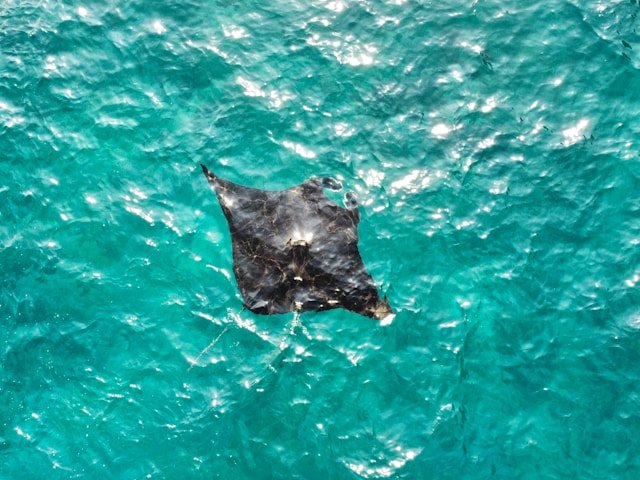
Diving with Manta Rays off Nusa Penida
Plunging into the waters around Manta Point for a dive with these gentle giants is a thrill, with dive shops charging $80-120 for a two-tank trip from Nusa Penida. The rays, some spanning 15 feet, glide by in crystal currents—September to November’s peak season for sightings. Certified divers get priority, but beginners can try a discovery dive with extra supervision. Book with reputable outfits like Blue Corner Dive for safety, and expect early starts to beat boat traffic. It’s a bucket-list adventure for ocean enthusiasts craving Bali’s underwater wow factor.
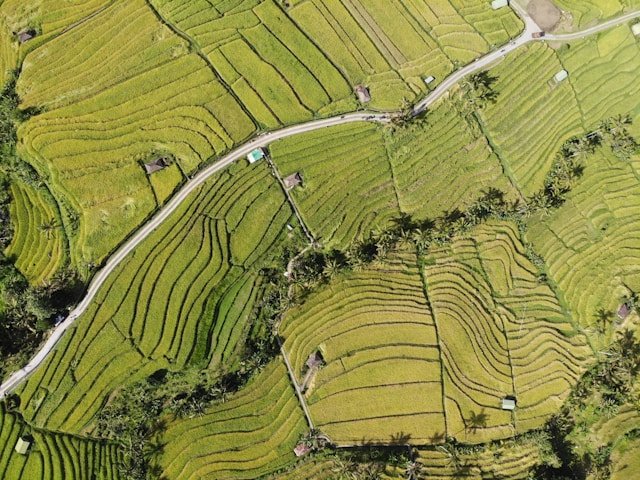
Cycling Through Jatiluwih Rice Terraces
Pedaling past the UNESCO-listed terraces of Jatiluwih is a serene way to soak up Bali’s countryside, with bike tours ($20-35) weaving through rice fields and sleepy villages. The rolling terrain’s gentle enough for casual riders—electric bikes are an option for less effort—and guides share tidbits on subak irrigation and local life. Morning rides dodge the midday sun, and a packed lunch of nasi bungkus often caps the trip. Wear sunscreen and bring water; rural shops are sparse. It’s a low-key, scenic escape for active travelers wanting Bali’s green heart.
Flights
Hotels
Tucked in Ubud’s heart, this boutique hotel wows with its lush, jungle-like grounds and infinity pool steps from the Monkey Forest. Guests love the airy rooms with Balinese touches—think carved wood and batik fabrics—plus rain showers and free minibar snacks. The staff’s next-level kindness, from arranging temple tours to serving afternoon tea, gets constant shout-outs. Breakfast is a feast of fresh tropical fruit, pancakes, and nasi goreng, often enjoyed by the lotus pond. Its walkable spot near Ubud Market and cafes makes exploring a breeze, blending tranquility with urban buzz.
Overlooking Seminyak Beach, this all-suite hotel blends sleek luxury with Balinese warmth, earning raves for its oceanfront infinity pool and sunset cocktails. Guests gush over the spacious suites—marble bathrooms, private balconies—and the staff’s knack for remembering names and preferences. The Wellness Centre’s massages and yoga classes are a hit, while the beachfront restaurant serves standout seafood and vegan dishes. It’s steps from Seminyak’s trendy boutiques and bars, yet feels like a serene escape. Reviewers call it a perfect mix of indulgence and island charm.
Set amid rice fields and the Petanu River, this Ubud retreat stuns with its sprawling gardens and two infinity pools that seem to melt into the jungle. Guests praise the elegant rooms—canopy beds, deep soaking tubs—and the spa’s Balinese massages using local herbs. The staff’s attentiveness, from free shuttle rides to Ubud center to personalized dining recommendations, shines through. Breakfast offers everything from smoothie bowls to mie goreng, served with valley views. It’s a peaceful haven for couples and wellness seekers, yet close enough to Ubud’s buzz.
Nestled in Seminyak’s vibrant core, this hidden gem charms guests with its private villas, each featuring plunge pools and open-air bathrooms surrounded by tropical gardens. Reviewers rave about the peaceful vibe—perfect for unwinding after exploring nearby Eat Street or Double Six Beach—paired with attentive staff who deliver fresh breakfasts (think banana pancakes and Balinese coffee) to your door. The Balinese decor, with carved wood and thatched roofs, feels authentic yet cozy, and free bikes let you cruise the neighborhood. It’s a short walk to Seminyak’s trendy cafes and shops, making it a favorite for those who want relaxation and convenience in one package.
Tucked in Canggu’s laid-back Berawa area, this boutique hotel wins hearts with its sleek, modern suites and a rooftop pool offering rice field views. Guests love the spacious rooms—think plush beds, rain showers, and little extras like complimentary coconut water—and the staff’s warmth, from arranging scooter rentals to sharing surf spot tips. Breakfast is a highlight, with avocado toast and tropical fruit platters served poolside, while the location puts you minutes from Batu Bolong Beach and Canggu’s hip cafes. It’s a stylish yet chill base for travelers craving Bali’s bohemian surf vibe without the chaos.
Essential Tips for Visiting Bali
Picking up a few phrases like “terima kasih” (thank you) or “berapa harganya?” (how much?) can make your Bali trip smoother—locals light up when you try, even if your accent’s off. English is common in tourist spots like Kuta or Ubud, but less so in rural areas, so a translation app like Google Translate (with offline mode) is a clutch backup for menus or chats. Pointing and smiling work wonders when words fail, and carrying a small notebook for jotting down names or prices helps too. It’s a small effort that opens doors and builds connections.
Bali’s a cash-driven spot—Indonesian rupiah (IDR) rules for warungs, markets, and small shops, though cards work at hotels and upscale restaurants. ATMs in tourist areas (use bank-affiliated ones to avoid skimmers) dispense cash, but carry small notes (Rp 10,000-50,000) since vendors often lack change for Rp 100,000 bills. Haggling’s standard at markets—aim for 50-70% of the quoted price—but keep it friendly. Stash extra cash in a money belt for peace of mind; losing a wad in a busy market stings.
Respecting Balinese Culture
Bali’s Hindu traditions shape daily life, so dress modestly at temples—sarongs and sashes are often required (rentable for $1)—and never point your feet at shrines or climb sacred sites for photos. Public affection’s frowned upon, so save PDA for private spots. Tipping’s not expected but appreciated—5-10% at restaurants or rounding up a taxi fare shows gratitude. Watch how locals act during ceremonies (like staying quiet or stepping aside), and follow their lead. Respect earns respect, and you’ll feel Bali’s warmth in return.
Packing for Bali’s Vibe
Pack light but smart—breathable clothes, flip-flops, and a sarong double as beach cover-ups or temple wear. A reusable water bottle cuts plastic waste (tap water’s unsafe, so buy bottled or use filters), and a power bank keeps your phone alive for navigation. Sunscreen’s pricier here, so bring your own, and toss in mosquito repellent for evenings—dengue’s a risk. Bali’s outlets use Type C/F plugs (220V), so grab an adapter if needed. Keep it minimal; you’ll want space for market finds like batik or carvings.
Bali’s food scene is a budget traveler’s jackpot—nasi goreng or mie goreng at warungs costs $1-3, but don’t sleep on babi guling (suckling pig) or bebek betutu for a splurge. Eating’s often communal, so share dishes family-style and dig in with your right hand or a spoon (forks are for pushing, not scooping). Spice is king—say “tidak pedas” for mild flavors, though options may shrink. Street stalls are safe if they’re busy and food’s fresh; look for crowds. Embrace the chaos of flavors—it’s Bali’s soul on a plate.
Bali Transportation Guide
Finding the Best Time to Visit
Landing in Bali during these months means sunny days and low humidity, with temps around 80-85°F (27-29°C)—perfect for beach hopping in Kuta or hiking Mount Batur. It’s peak season, especially July-August, so expect crowds at Tanah Lot or Ubud’s rice terraces and higher hotel rates (book 3-6 months out). Surf’s up in Canggu, and festivals like Galungan bring vibrant temple ceremonies—check lunar calendars for dates. Rain’s rare, but mornings can be hazy; sunscreen’s a must. It’s Bali at its busiest and brightest, ideal for sun-seekers and party-goers chasing the island’s high-energy vibe.
Slipping into Bali just before or after the dry season offers a Goldilocks balance—decent weather (80-85°F) with occasional showers, fewer tourists, and lower prices. March sees Nyepi, Bali’s silent day, when everything shuts down (even the airport)—a unique cultural experience if you’re ready to stay put. October’s quieter beaches and temples make it easier to snag spots at Uluwatu or Tegalalang without elbowing through crowds. Hotels drop rates 20-30% from peak, and last-minute bookings are safer. It’s a smart pick for budget travelers wanting Bali’s beauty with breathing room.
Bali’s wet season brings daily downpours—often short but heavy—with humidity cranking up to 80% and temps at 80-90°F (27-32°C). Flooding can snarl roads in Denpasar, but indoor spots like Ubud’s art galleries or Seminyak’s cafes shine. Hotel deals are steep (30-50% off), and crowds vanish, making it a haven for backpackers or couples craving quiet. Surf’s still good on east coast breaks like Keramas, and lush greenery pops—think rice fields at their greenest. Pack a poncho and embrace the calm; it’s Bali’s budget-friendly, introspective side.
Festival-Filled February
If you time it right, February (late rainy season) mixes low-season perks with cultural highs, like Chinese New Year or smaller temple festivals—check local calendars for exact dates. Rain’s tapering off, but you’ll still score deals on villas in Canggu or guesthouses in Ubud, with temps around 85°F (29°C). Beaches like Jimbaran are less packed, letting you savor seafood sunsets in peace. Mosquitoes are peskier, so repellent’s key, and some rural trails get muddy—stick to paved paths. It’s a niche window for travelers who love a festive yet affordable Bali escape.
Value Index
Bali’s a budget traveler’s paradise, offering high-quality experiences at low costs. A dorm bed runs $7-15, mid-range hotels $30-50, and meals at warungs (nasi goreng, sate) cost $1-3—street food’s even cheaper. Activities like temple visits ($1-3 entry) or snorkeling ($10-20) are steals, and scooters ($5/day) keep transport dirt-cheap. Even splurges—think Ubud cooking classes ($25) or Nusa Penida dives ($80)—deliver big for the price compared to Western destinations.
